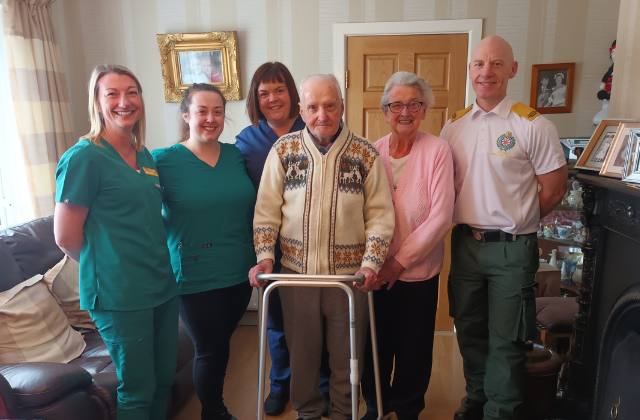You are here
Letterkenny Pathfinder Service is successfully preventing hospital admissions for older patients

One year after launching in Donegal, the HSE Pathfinder team have been called out to the homes of 511 older people in the region, and managed to keep 81% of patients safely at home.
Letterkenny Pathfinder is also the first pilot site nationally to trial an innovative new point of care blood test. The bedside blood test means the Pathfinder Advanced Paramedic can analyse patient blood samples for dehydration and infection markers in their own home and relay the results directly back to their GP for a decision about their onward care.
Pathfinder is a partnership between the National Ambulance Service (NAS) and Letterkenny University Hospital (LUH). The team respond to 999/112 calls for older people (over the age of 65) with the aim of assessing and treating the person in their own home. The national programme was rolled out in the Letterkenny region in April 2023.
Gary Gardiner is an Advanced Paramedic with NAS, “The type of patient we see with Pathfinder is an older person who has maybe had a fall, or is experiencing reduced mobility, loss of appetite or they might have signs of an infection. When we call to the home, the patient is assessed by both an Advanced Paramedic and Occupational Therapist / Physiotherapist and if it’s safe and appropriate for the older person to be treated at home and recuperate at home then we will support them to achieve that.
“Follow up care is a really important aspect of Pathfinder and we work closely with hospital, community and voluntary services to ensure the patient has access to alternative pathways of care rather than going to hospital for these services.
“We have seen very high stay at home rates in our first year of operation, over 410 people have avoided an ED visit and we are very proud of these outcomes.”
Raphoe couple Claire and Frank Laird have shared their experience of using the service in recent weeks. Frank became unwell at home and their GP called for an ambulance. The Pathfinder team were able to treat Frank at home instead of bringing him to the emergency department, and with targeted supports and a number of follow up visits including physiotherapy, the team helped to get Frank back on his feet again.
“I can’t say enough about the Pathfinder team. Frank was adamant he didn’t want to be admitted to hospital and the team made several visits to ensure he had everything he needed and was recovering well at home. They were a great support to both of us, he was a star pupil and responded really well, thanks to all the extra help we got. I’d love for more people to know about Pathfinder, because it’s such a fantastic service,” said Claire.
The new blood testing pilot project which Letterkenny Pathfinder is trialling is a major enhancement to the service. John Joe Mc Gowan, Chief Officer with National Ambulance Service West said, “Point of care blood testing is a huge step forward in terms of delivering care closer to home and I’m very pleased to see this initiative in Letterkenny.
“This community-based triage tool could have huge potential to reduce unnecessary hospital admissions for our older patients. With the oversight and clinical guidance of a GP, we can quickly diagnose and treat low level infections or dehydration which in other circumstances might require a hospital attendance. Since launching the trial we have carried out nine point of care blood tests and seven patients were successfully treated at home by our Advanced Paramedics.”
Sean Murphy, LUH Hospital Manager added, “We know that people are living longer and many older people have complex conditions so it is important to recognise and address the challenges faced by these patients. For frail older adults, a hospital stay may result in a loss of independence and a need for extra assistance on discharge. If it’s safe and appropriate for these patients to be assessed, treated and supported at home, that is obviously the preferred outcome.
“The Pathfinder service is a great success story in terms of integrated working across our health system which can be seen in a reduction in ED presentations for this group of patients; helping with patient flow and relieving pressures on bed availability in the hospital.”

